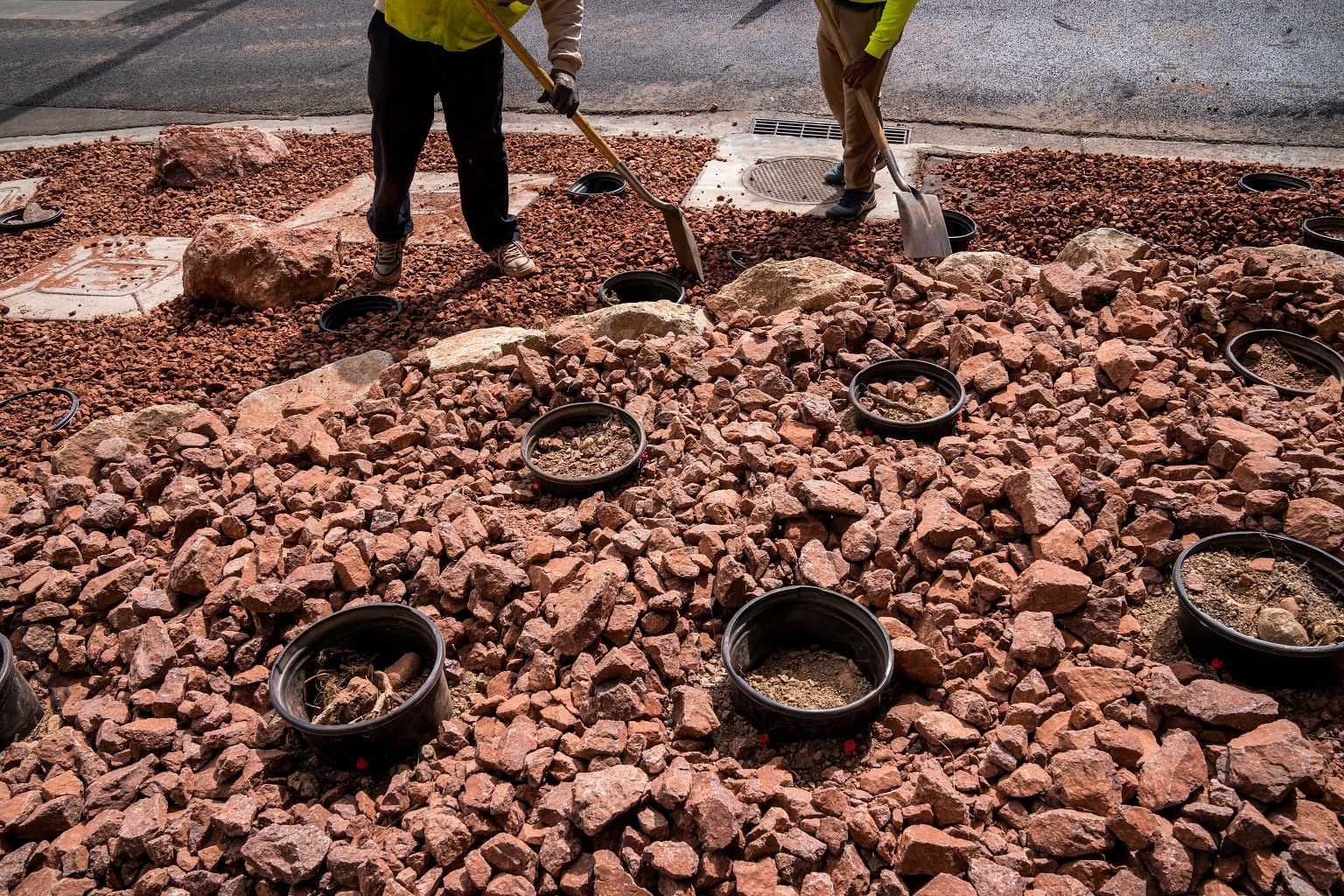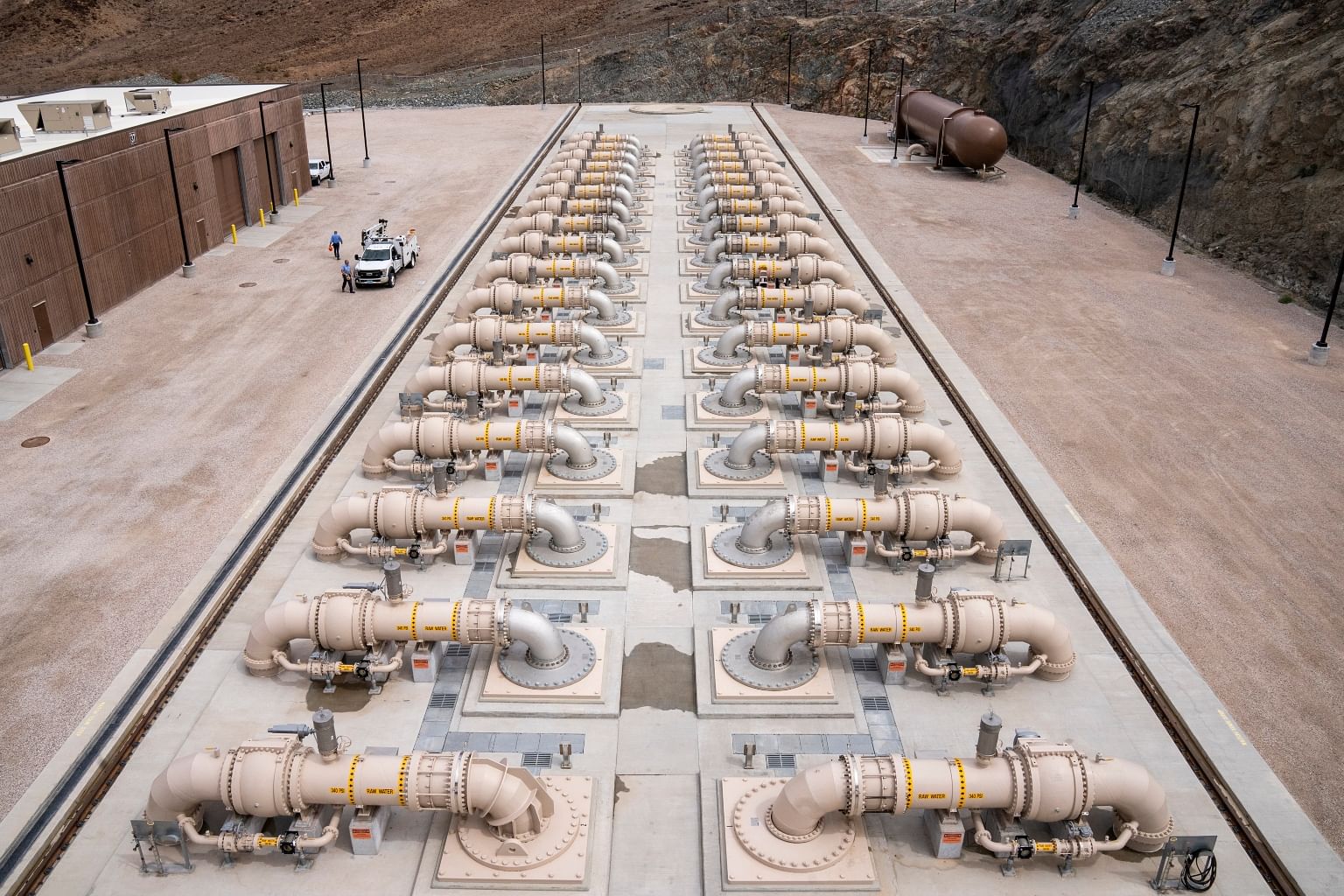LAS VEGAS (NYTIMES) - It was a perfectly decent patch of lawn, several hundred square feet of grass in a condominium community on this city's western edge. But Mr Jaime Gonzalez, a worker with a local landscaping firm, had a job to do.
Wrangling a heavy gas-powered sod cutter, Mr Gonzalez sliced the turf away from the soil underneath, like peeling a potato. Two co-workers followed, gathering the strips for disposal.
Mr Gonzalez took little pleasure in destroying this patch of rescue. "But it's better to replace it with something else," he said. The ground would soon be covered with gravel dotted with plants such as desert spoon and red yucca.
Under a state law passed last year that is the first of its kind in the nation, patches of grass like this, found along streets and at housing developments and commercial sites in and around Las Vegas, must be removed in favour of more desert-friendly landscaping.
The offence? They are "non-functional," serving only an aesthetic purpose. Seldom, if ever, walked on and kept alive by sprinklers, they are wasting a resource, water, that has become increasingly precious.
Outlawing grass is perhaps the most dramatic effort yet to conserve water in the Southwest, where decades of growth and 20 years of drought made worse by a warming climate have led to dwindling supplies from the Colorado River, which serves Nevada and six other states, Native American tribes and Mexico.
For Southern Nevada, home to nearly 2.5 million people and visited by upward of 40 million tourists a year, the problem is particularly acute. The region depends on Lake Mead, the nearby reservoir behind Hoover Dam on the Colorado, for 90 per cent of its drinking water.
The lake has been shrinking since 2000, and is now so low the original water intake was exposed last week. The regional water utility, the Southern Nevada Water Authority, has been so concerned that it spent US$1.5 billion (S$2 billion) over a decade building a much deeper intake and a new pumping station, recently put into operation, so it can take water even as the level continues to drop.
The new law, which passed with bipartisan support, is meant to help ensure that what water there is goes further. It is an example of the kind of strict measures that other regions may increasingly be forced to take to mitigate and adapt to the effects of climate change.
It also illustrates the choices, some hard, some mundane, that have to be made to carry those measures out. Here, an advisory committee of community members, with help from the authority, decided what was functional turf (including athletic fields, cemeteries and some parcels in housing developments based on size) and what would have to go (most everything else). The law set a deadline of 2027 for the work to be completed.
Mr Kurtis Hyde, maintenance manager at Par 3 Landscape and Maintenance, the company where Mr Gonzalez works, said at some homeowners association meetings he has attended that residents have been quite vocal about the prospect of losing turf. "People get emotional about grass," he said.
The ban follows years of extensive efforts to cut water use, including a voluntary "cash for grass" programme, begun in 1999, for individual homeowners to lose their lawns, limits on watering, and the establishment of a team of water waste investigators. But with no end in sight for the drought, and with the region's continued growth, measures like these have not been enough, said Mr John Entsminger, the authority's general manager.
"Our community has been a world leader in urban water conservation for the last 20 years," Mr Entsminger said. "We have to do even better over the next 20."

The move to replace thirsty, sprinkler-fed grass with drought-tolerant, drip-irrigated plants can reduce water use by up to 70 per cent, the water authority says. The savings are even greater if the grass is replaced by artificial turf, which is favoured by some.
Outlaw grass is easy to spot. It is found at roundabouts and on median strips, adjoins sidewalks and adorns strip malls and office buildings. It is especially prevalent at the common areas of the residential developments that are found all over Las Vegas and neighbouring cities.
"There are little useless pieces of grass everywhere," Mr Hyde said.

The authority estimates there are about 3,900 acres of grass to be removed, which could yield savings of up to 9.5 billion gallons (43 billion litres) of water annually, or about 10 per cent of the region's allocation from the Colorado.
Customers get a rebate, starting at US$3 per square foot, but in most cases that does not come close to covering the cost of removal and replacement with other plants.
"The cost is huge," said Mr Larry Fossan, facilities maintenance manager at Sun City Anthem, one of the largest planned communities in the area.
Even before the law was passed, Mr Fossan had been removing grass and installing sophisticated irrigation equipment to reduce water use and save money. But now under the law's terms, which he helped set as a member of the advisory committee, one of the lawns around the community's main clubhouse is on the chopping block.
Mr Howard Watts, a Democratic state assemblyman from Las Vegas who sponsored the turf ban bill, said it will raise more awareness of the scope of the problem the region faces.
"The lush green landscape creates a false sense of security," Mr Watts said. The law "will help people who may have a bit of a disconnect - you know, whenever they turn it on, the tap water always comes out. I think it's going to change that".

Water used indoors is treated through the sewer system and eventually flows back to Lake Mead. But more than half of the region's water is used outdoors, and most of that is lost through evaporation. It has long been the focus of the water authority's conservation efforts.
In addition to its "cash for grass" programme, the agency successfully pushed for building codes that sharply reduced the amount of grass allowed around newer homes.

For homeowners that still have lawns, the agency's team of investigators makes sure they are observed.
Early one recent morning one of the investigators, Mr Cameron Donnarumma, was slowly driving his patrol car along a residential street, following a stream of water running down the curb. He stopped in front of the culprit, a house with a green lawn and a wet sidewalk. The sprinklers were improperly adjusted and much of the spray was hitting the sidewalk and draining to the curb.
These and other efforts have helped cut per-person water consumption by about half since the drought began in 2000. But the current daily consumption has remained largely flat for much of the past decade, when the region's population grew by more than 20 per cent. And more growth is forecast.

